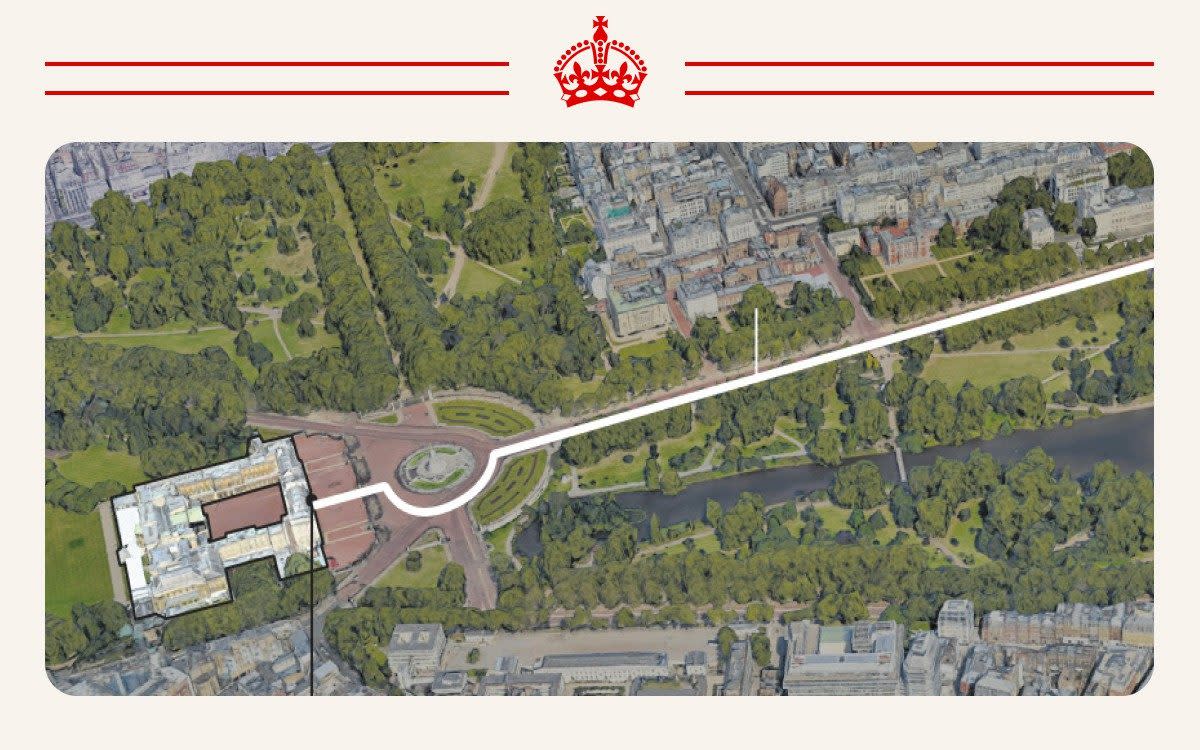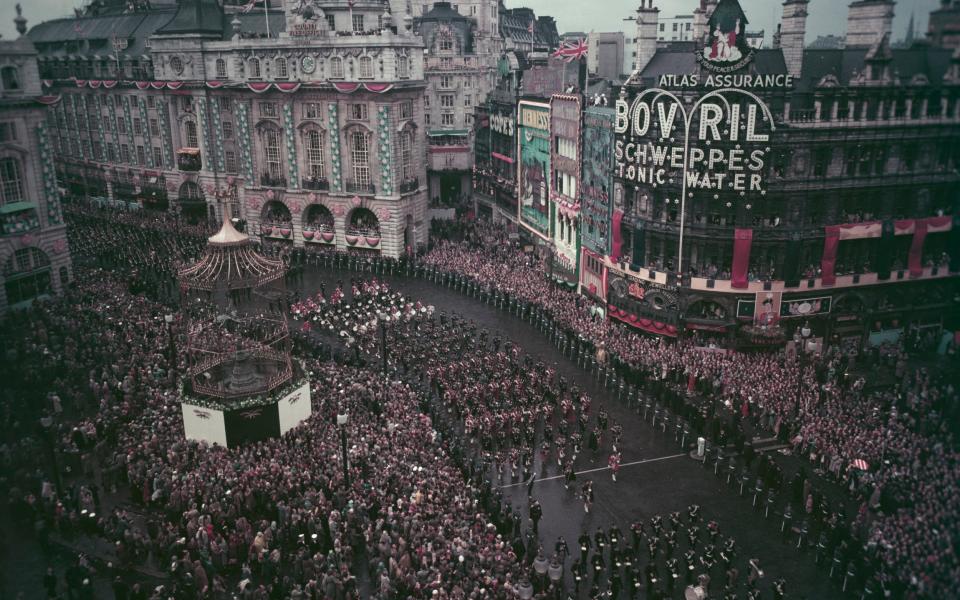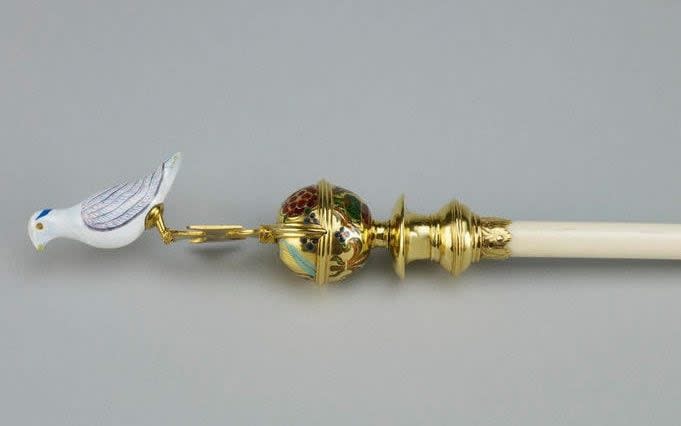King's Coronation procession route revealed to be fraction of length of Queen Elizabeth's

The King's Coronation procession will be a fraction of the length of his late mother's, raising fears that many royal well-wishers may miss out on the chance to see the new monarch.
The 1.3-mile route will take the King and Queen from Westminster Abbey to Buckingham Palace but avoid large sections of the capital that were taken in during Queen Elizabeth II’s 1953 five-mile Coronation procession.
It will be the reverse of their journey to the Abbey, meaning people who have managed to secure a spot lining the route on the Mall or at Whitehall will see the King twice.
However, many face missing out as the procession will double back on itself, rather than travelling around central London.
The plans mean crowds on the route of the procession are expected to be even larger than on other royal occasions.
The Telegraph understands organisers are not intending to set up a ticketing or ballot system for the route, meaning fans may have to camp for days in advance to be in with a chance of seeing the King on May 6.
One insider advised those travelling to London for the Coronation to “plan in advance” amid concerns day-trippers may not see the monarch and the Queen at all.
Those who cannot get a spot on the route can watch the procession on outdoor screens in locations across the UK, including Hyde Park, Green Park and St James’s Park in London.
Details of the regalia to be used during the Coronation have also been announced, including the Sovereign’s Sceptre with Cross representing the Sovereign's temporal power and good governance, and the silver-gilt Coronation Spoon.
This is the oldest object in use at coronations, having been first recorded in 1349 among St Edward’s Regalia in Westminster Abbey. However, experts have admitted that they do not know its original purpose.

It has also been confirmed that the Queen will use an ivory sceptre during the Coronation following speculation it might be dropped from the ceremony.
She will hold the Rod with Dove, despite reports that it would not be used given the Prince of Wales's campaign to stop the illegal trafficking of animal parts such as ivory.
A spokesman for Buckingham Palace said: “The Coronation Regalia are sacred objects which symbolise the powers and responsibilities of the monarch.
“The Regalia have played a central role in coronation services for hundreds of years and, in keeping with tradition, will be used at Westminster Abbey on May 6.”

More than 8,000 guests from 129 nations travelled to Westminster Abbey for the Coronation of Queen Elizabeth II. However, the King's Coronation will be limited to 2,000 to accommodate modern health and safety restrictions.
Their Majesties will ride in the Diamond Jubilee State Coach, created for Queen Elizabeth II to commemorate the 60th anniversary of her reign in 2012, for their journey from the Palace to the Abbey - known as the King's Procession.
Around 5,000 Armed Forces personnel will accompany their Sovereign from Buckingham Palace to Westminster Abbey and back in two separate processions.
The first, The King’s Procession, is the smaller in scale of the two and will feature just under 200 members, centred around The Sovereign’s Escort of The Household Cavalry Mounted Regiment.
The procession will leave Buckingham Palace through the Centre Gate, and proceed down The Mall, passing through Admiralty Arch and along the south side of Trafalgar Square, down Whitehall and along Parliament Street.
Travelling down The Mall to Trafalgar Square, where they’ll turn onto Whitehall before marching to Westminster Abbey, where the Coronation Service will begin at 11am. The Procession will cover 1.42 miles and flanking them will be over 1,000 Forces route liners from all three services.
The return procession from Westminster Abbey to Buckingham Palace, called the Coronation Procession, will take the same route in reverse but be larger in scale.
Featuring nearly 4,000 personnel, this major military ceremonial operation will be the largest of its kind for a generation.
It will include Armed Forces from across the Commonwealth and the British Overseas Territories, and all Services of the Armed Forces of the United Kingdom, alongside The Sovereign’s Bodyguard and Royal Watermen.
The Royal British Legion will provide a Guard of Honour of 100 Standard Bearers to line the procession route in Parliament Square on the day of the Coronation.
Their Majesties will travel back to Buckingham Palace in the Gold State Coach, last seen during the Pageant of the Platinum Jubilee of Queen Elizabeth II in June 2022.
The Gold State Coach was commissioned in 1760 and was first used by King George III to travel to the State Opening of Parliament in 1762. It has been used at every Coronation since that of William IV in 1831.
The restricted route of the Coronation Procession is in marked contrast to that undertaken by the late Queen in 1953.
Then, Her Majesty travelled through Whitehall to Trafalgar Square, passing through Pall Mall, Hyde Park Corner, Marble Arch and Oxford Circus on the journey back to Buckingham Palace from Westminster Abbey. The five-mile route took two hours to complete.
When the King and Queen return to Buckingham Palace following the Coronation Service, they will receive a Royal Salute from the United Kingdom and Commonwealth Armed Forces on parade that day.
Their Majesties will take the salute from the West Terrace of the Buckingham Palace Garden, followed by three cheers from the assembled service personnel.
Military personnel will then conduct a breath-taking six-minute flypast of more than 60 aircraft from the Royal Navy, British Army and Royal Air Force flying over The Mall in Central London.
The Royal Air Force Aerobatic Team – the Red Arrows – will follow dozens of aircraft used by the Armed Forces on operations around the world. Featured amongst the aerial procession will be aircraft that have delivered support to Ukraine, policed NATO airspace, supported disaster relief, deterred drug trafficking and countered terrorism in the Middle East and Africa.
Included will be 16 helicopters, the historic Spitfires of the RAF Battle of Britain Memorial Flight, the RAF’s brand-new P-8A Poseidon maritime patrol aircraft, Joint RAF and RN crewed state-of-the art F-35B Lightning II jets and transport aircraft from the RAF’s Air Mobility Force. It will feature the first flypast involvement of the RAF’s new Envoy IV CC1 aircraft.
Gun salutes
From military bases in all corners of the country, including at firing stations in Edinburgh, Cardiff and Belfast, and on His Majesty’s ships at sea, gun salutes will sound out to herald the moment when The King is crowned.
Featuring more than 400 personnel, across 13 locations and deployed Royal Navy ships, 21 rounds will fire to mark the Coronation with the exception of The Tower of London and Horse Guards Parade, where a 62 round salute and a six-gun salvo will fire respectively.
How can you watch the Coronation processions in person?
Well-wishers can flock to central London to catch a glimpse of the processions as the King and Queen head to Westminster Abbey and return to Buckingham Palace.
Around 3,800 seats in a specially-built grandstand in front of Buckingham Palace will be offered to veterans, NHS and social care workers, and representatives of charitable organisations with links to The Royal Family. Additionally 354 uniformed cadet forces will be offered the opportunity to watch the Procession at Admiralty Arch.
There will be viewing areas lining The Mall and Whitehall that have limited capacity and may close before the events begin.
After the ceremony, the 1.3-mile Coronation procession route will take the King and Queen from Westminster Abbey to Buckingham Palace, but avoid large sections of the capital that were taken in during Queen Elizabeth II’s 1953 five-mile route.
It will be the reverse of their journey to the Abbey, meaning people who have managed to secure a spot lining the route will see the King twice.
More than 57 locations across the UK, from Bournemouth to Belfast, will also be putting up big screens with three locations in London.


